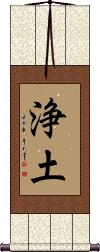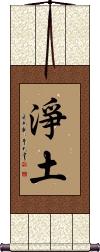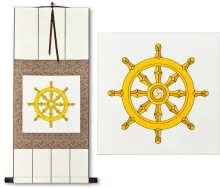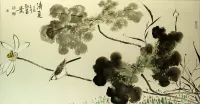Many custom options...
And formats...

Pure Land Buddhism Jodo Buddhism in Chinese / Japanese...
Buy a Pure Land Buddhism Jodo Buddhism calligraphy wall scroll here!
Personalize your custom “Pure Land Buddhism Jodo Buddhism” project by clicking the button next to your favorite “Pure Land Buddhism Jodo Buddhism” title below...
Pure Land Buddhism / Jodo Buddhism
浄土宗 is the title of Japanese “Pure Land Buddhism.” This form is also romanized/known as “Jodo Shu” (jōdo shū).
Also known as Amidism for the fact that this is a branch of Mahayana (Mahāyāna) Buddhism which focuses on Amitabha (Amitābha) Buddha. This form of Buddhism, along with Chinese characters, came to Japan via China in the 5th century, according to most historians.
Notes:
Pure Land Buddhism is also known as ![]()
![]()
![]()
![]() (jōdo bukkyō).
(jōdo bukkyō).
Some will just express it with just ![]()
![]() (Pure Land).
(Pure Land).
See Also: Shin Buddhism
Pure Land / Jodo
浄土 means “Pure Land.”
This term, “Pure Land” is often associated with the Western Pure Land paradise of Amitabha, also known as the “Buddhist paradise.”
浄土 can also be used as an abbreviation for “Pure Land Buddhism.”
You may see this romanized as Jodo, Joudo, or Jōdo. Some also combine Pure Land into Pureland in English.
This can also be a Japanese surname with the same Jodo or Joudo pronunciation.
See Also: Shin Buddhism
Pure Land / Jodo
Also a sect of Buddhism
淨土 literally means “pure land” or “clean earth.”
淨土 is also the abbreviated title of a Buddhist sect that involves faith in the rebirth of Buddha Amitabha (Amitābha) in the Western Heaven. Sometimes this sect is translated as “Paradise of the West.” Other titles of this school of Buddhism include Amidism or Elysium.
See Also: Nirvana | Shin Buddhism
This in-stock artwork might be what you are looking for, and ships right away...
Starting at: $28.88
Gallery Price: $108.00
Your Price: $59.88
Gallery Price: $79.00
Your Price: $43.88
Not the results for pure land buddhism jodo buddhism that you were looking for?
Below are some entries from our dictionary that may match your pure land buddhism jodo buddhism search...
| Characters If shown, 2nd row is Simp. Chinese |
Pronunciation Romanization |
Simple Dictionary Definition |
浄土 see styles |
joudo / jodo じょうど |
More info & calligraphy: Pure Land / Jodo |
淨土 净土 see styles |
jìng tǔ jing4 tu3 ching t`u ching tu jōdo |
More info & calligraphy: Pure Land / JodoSukhāvatī. The Pure Land, or Paradise of the West, presided over by Amitābha. Other Buddhas have their Pure Lands; seventeen other kinds of pure land are also described, all of them of moral or spiritual conditions of development, e.g. the pure land of patience, zeal, wisdom, etc. |
浄土宗 see styles |
joudoshuu / jodoshu じょうどしゅう |
More info & calligraphy: Pure Land Buddhism / Jodo Buddhism |
淨土宗 净土宗 see styles |
jìng tǔ zōng jing4 tu3 zong1 ching t`u tsung ching tu tsung Jōdo Shū |
More info & calligraphy: Pure Land Buddhism / Jodo BuddhismThe Pure-land sect, whose chief tenet is salvation by faith in Amitābha; it is the popular cult in China, also in Japan, where it is the Jōdo sect; it is also called 蓮宗(蓮花宗) the Lotus sect. Established by Hui-yuan 慧遠 of the Chin dynasty (317— 419), it claims P'u-hsien 普賢 Samantabhadra as founder. Its seven chief textbooks are 無量淸淨平等覺經; 大阿彌陀經; 無量壽經; 觀無量壽經; 阿彌陀經; 稱讚淨土佛攝受經; and 鼓音聲三陀羅尼經. The淨土眞宗 is the Jōdo-Shin, or Shin sect of Japan. |
十宗 see styles |
shí zōng shi2 zong1 shih tsung jūshū |
The ten schools of Chinese Buddhism: I. The (1) 律宗 Vinaya-discipline, or 南山|; (2) 倶舍 Kośa, Abhidharma, or Reality (Sarvāstivādin) 有宗; (3) 成實宗 Satyasiddhi sect founded on this śāstra by Harivarman; (4) 三論宗 Mādhyamika or 性空宗; (5) 法華宗 Lotus, "Law-flower" or Tiantai 天台宗; (6) 華嚴Huayan or法性 or賢首宗; ( 7) 法相宗 Dharmalakṣana or 慈恩宗 founded on the唯識論 (8) 心宗 Ch'an or Zen, mind-only or intuitive, v. 禪宗 ; (9) 眞言宗 (Jap. Shingon) or esoteric 密宗 ; (10) 蓮宗 Amitābha-lotus or Pure Land (Jap. Jōdo) 淨士宗. The 2nd, 3rd, 4th, and 9th are found in Japan rather than in China, where they have ceased to be of importance. II. The Hua-yen has also ten divisions into ten schools of thought: (1) 我法倶有 the reality of self (or soul) and things, e.g. mind and matter; (2) 法有我無 the reality of things but not of soul; (3) 法無去來 things have neither creation nor destruction; (4) 現通假實 present things are both apparent and real; (5) 俗妄眞實 common or phenomenal ideas are wrong, fundamental reality is the only truth; (6) things are merely names; (7) all things are unreal 空; (8) the bhūtatathatā is not unreal; (9) phenomena and their perception are to be got rid of; (10) the perfect, all-inclusive, and complete teaching of the One Vehicle. III. There are two old Japanese divisions: 大乘律宗, 倶舎宗 , 成實 宗 , 法和宗 , 三論宗 , 天台宗 , 華嚴宗 , 眞言宗 , 小乘律宗 , and 淨土宗 ; the second list adds 禪宗 and omits 大乘律宗. They are the Ritsu, Kusha, Jōjitsu, Hossō, Sanron, Tendai, Kegon, Shingon, (Hīnayāna) Ritsu, and Jōdo; the addition being Zen. |
宗派 see styles |
zōng pài zong1 pai4 tsung p`ai tsung pai shuuha / shuha しゅうは |
sect (1) sect; denomination; (2) school (e.g. of poetry) Sects (of Buddhism). In India, according to Chinese accounts, the two schools of Hīnayāna became divided into twentysects. Mahāyāna had two main schools, the Mādhyamika, ascribed to Nāgārjunaand Āryadeva about the second century A. D., and the Yogācārya, ascribed toAsaṅga and Vasubandhu in the fourth century A. D. In China thirteen sectswere founded: (1) 倶舍宗 Abhidharma or Kośa sect, representing Hīnayāna,based upon the Abhidharma-kosa-śāstra or 倶舍論. (2) 成實宗 Satyasiddhi sect, based on the 成實論 Satyasiddhi-śāstra,tr. by Kumārajīva; no sect corresponds to it in India; in China and Japan itbecame incorporated in the 三論宗. (3) 律宗 Vinaya or Discipline sect, basedon 十誦律, 四分律, 僧祗律, etc. (4) 三論宗 The three śāstra sect, based on theMādhyamika-śāstra 中觀論 of Nāgārjuna, theSata-śāstra 百論 of Āryadeva, and theDvādasa-nikāya-śāstra 十二門論 of Nāgārjuna; this schooldates back to the translation of the three śāstras by Kumārajīva in A. D. 409. (5) 涅槃宗 Nirvāṇasect, based upon the Mahāparinirvāṇa-sūtra 涅槃經 tr. byDharmaraksa in 423; later incorporated in Tiantai, with which it had much incommon. (6) 地論宗 Daśabhūmikā sect, based on Vasubandhu's work on the tenstages of the bodhisattva's path to Buddhahood, tr. by Bodhiruci 508,absorbed by the Avataṃsaka school, infra. (7) 淨土宗 Pure-land or Sukhāvatīsect, founded in China by Bodhiruci; its doctrine was salvation throughfaith in Amitābha into the Western Paradise. (8) 禪宗 dhyāna, meditative or intuitional sect, attributed toBodhidharma about A. D. 527, but it existed before he came to China. (9) 攝論宗, based upon the 攝大乘論 Mahāyāna-saṃparigraha-śāstra byAsaṅga, tr. by Paramārtha in 563, subsequently absorbed by the Avataṃsakasect. (10) 天台宗 Tiantai, based on the 法華經 SaddharmapuṇḍarīkaSūtra, or the Lotus of the Good Law; it is aconsummation of the Mādhyamika tradition. (11) 華嚴宗 Avataṃsaka sect, basedon the Buddhāvataṃsaka-sūtra, or Gandha-vyūha 華嚴經 tr. in 418. (12) 法相宗 Dharmalakṣaṇa sect, established after thereturn of Xuanzang from India and his trans. of the important Yogācāryaworks. (13) 眞言宗 Mantra sect, A. D. 716. In Japan twelve sects are named:Sanron, Hossō, Kegon, Kusha, Jōjitsu, Ritsu, Tendai, Shingon; these areknown as the ancient sects, the two last being styled mediaeval; therefollow the Zen and Jōdo; the remaining two are Shin and Nichiren; at presentthere are the Hossō, Kegon, Tendai, Shingon, Zen, Jōdo, Shin, and Nichirensects. |
一向宗 see styles |
yī xiàng zōng yi1 xiang4 zong1 i hsiang tsung ikkoushuu / ikkoshu いっこうしゅう |
(See 浄土真宗) Ikkō sect (of Buddhism); Jōdo Shinshū; True Pure Land School The 眞宗 Shin or Pure-land Shin Sect founded by Shinran, in Japan, whose chief tenet is unwavering reflection on Amida (by repeating his name). |
阿彌陀 阿弥陀 see styles |
ā mí tuó a1 mi2 tuo2 a mi t`o a mi to Amida あみだ |
(out-dated kanji) (1) (Buddhist term) Amitabha (Buddha); Amida; (2) (kana only) (abbreviation) ghostleg lottery; ladder lottery; lottery in which participants trace a line across a lattice pattern to determine the winner; (3) (kana only) (abbreviation) wearing a hat pushed back on one's head (阿彌) amita, boundless, infinite; tr. by 無量 immeasurable. The Buddha of infinite qualities, known as 阿彌陀婆 (or 阿彌陀佛) Amitābha, tr. 無量光 boundless light; 阿彌陀廋斯Amitāyus, tr. 無量壽 boundless age, or life; and among the esoteric sects Amṛta 甘露 (甘露王) sweet-dew (king). An imaginary being unknown to ancient Buddhism, possibly of Persian or Iranian origin, who has eclipsed the historical Buddha in becoming the most popular divinity in the Mahāyāna pantheon. His name indicates an idealization rather than an historic personality, the idea of eternal light and life. The origin and date of the concept are unknown, but he has always been associated with the west, where in his Paradise, Suikhāvatī, the Western Pure Land, he receives to unbounded happiness all who call upon his name (cf. the Pure Lands 淨土 of Maitreya and Akṣobhya). This is consequent on his forty-eight vows, especially the eighteenth, in which he vows to refuse Buddhahood until he has saved all living beings to his Paradise, except those who had committed the five unpardonable sins, or were guilty of blasphemy against the Faith. While his Paradise is theoretically only a stage on the way to rebirth in the final joys of nirvana, it is popularly considered as the final resting-place of those who cry na-mo a-mi-to-fo, or blessed be, or adoration to, Amita Buddha. The 淨土 Pure-land (Jap. Jōdo) sect is especially devoted to this cult, which arises chiefly out of the Sukhāvatīvyūha, but Amita is referred to in many other texts and recognized, with differing interpretations and emphasis, by the other sects. Eitel attributes the first preaching of the dogma to 'a priest from Tokhara' in A. D.147, and says that Faxian and Xuanzang make no mention of the cult. But the Chinese pilgrim 慧日Huiri says he found it prevalent in India 702-719. The first translation of the Amitāyus Sutra, circa A.D. 223-253, had disappeared when the Kaiyuan catalogue was compiled A.D. 730. The eighteenth vow occurs in the tr. by Dharmarakṣa A.D. 308. With Amita is closely associated Avalokiteśvara, who is also considered as his incarnation, and appears crowned with, or bearing the image of Amita. In the trinity of Amita, Avalokiteśvara appears on his left and Mahāsthāmaprāpta on his right. Another group, of five, includes Kṣitigarbha and Nāgārjuna, the latter counted as the second patriarch of the Pure Land sect. One who calls on the name of Amitābha is styled 阿彌陀聖 a saint of Amitābha. Amitābha is one of the Five 'dhyāni buddhas' 五佛, q.v. He has many titles, amongst which are the following twelve relating to him as Buddha of light, also his title of eternal life: 無量光佛Buddha of boundless light; 無邊光佛 Buddha of unlimited light; 無礙光佛 Buddha of irresistible light; 無對光佛 Buddha of incomparable light; 燄王光佛 Buddha of yama or flame-king light; 淸淨光佛 Buddha of pure light; 歡喜光佛 Buddha of joyous light; 智慧光佛 Buddha of wisdom light; 不斷光佛 Buddha of unending light; 難思光佛 Buddha of inconceivable light; 無稱光佛Buddha of indescribable light; 超日月光佛 Buddha of light surpassing that of sun and moon; 無量壽 Buddha of boundless age. As buddha he has, of course, all the attributes of a buddha, including the trikāya, or 法報化身, about which in re Amita there are differences of opinion in the various schools. His esoteric germ-letter is hrīḥ, and he has specific manual-signs. Cf. 阿彌陀經, of which with commentaries there are numerous editions. |
浄土三部経 see styles |
joudosanbukyou / jodosanbukyo じょうどさんぶきょう |
(See 無量寿経,阿弥陀経,観無量寿経) three major sutras of Pure Land Buddhism; (person) Jōdo Sanbukyō |
The following table may be helpful for those studying Chinese or Japanese...
| Title | Characters | Romaji (Romanized Japanese) | Various forms of Romanized Chinese | |
| Pure Land Buddhism Jodo Buddhism | 淨土宗 浄土宗 | jou do shuu joudoshuu jo do shu | jìng tǔ zōng jing4 tu3 zong1 jing tu zong jingtuzong | ching t`u tsung chingtutsung ching tu tsung |
| Pure Land Jodo | 浄土 | jou do / joudo / jo do | jìng tǔ / jing4 tu3 / jing tu / jingtu | ching t`u / chingtu / ching tu |
| Pure Land Jodo | 淨土 净土 | jou do / joudo / jo do | jìng tǔ / jing4 tu3 / jing tu / jingtu | ching t`u / chingtu / ching tu |
| In some entries above you will see that characters have different versions above and below a line. In these cases, the characters above the line are Traditional Chinese, while the ones below are Simplified Chinese. | ||||
Successful Chinese Character and Japanese Kanji calligraphy searches within the last few hours...











